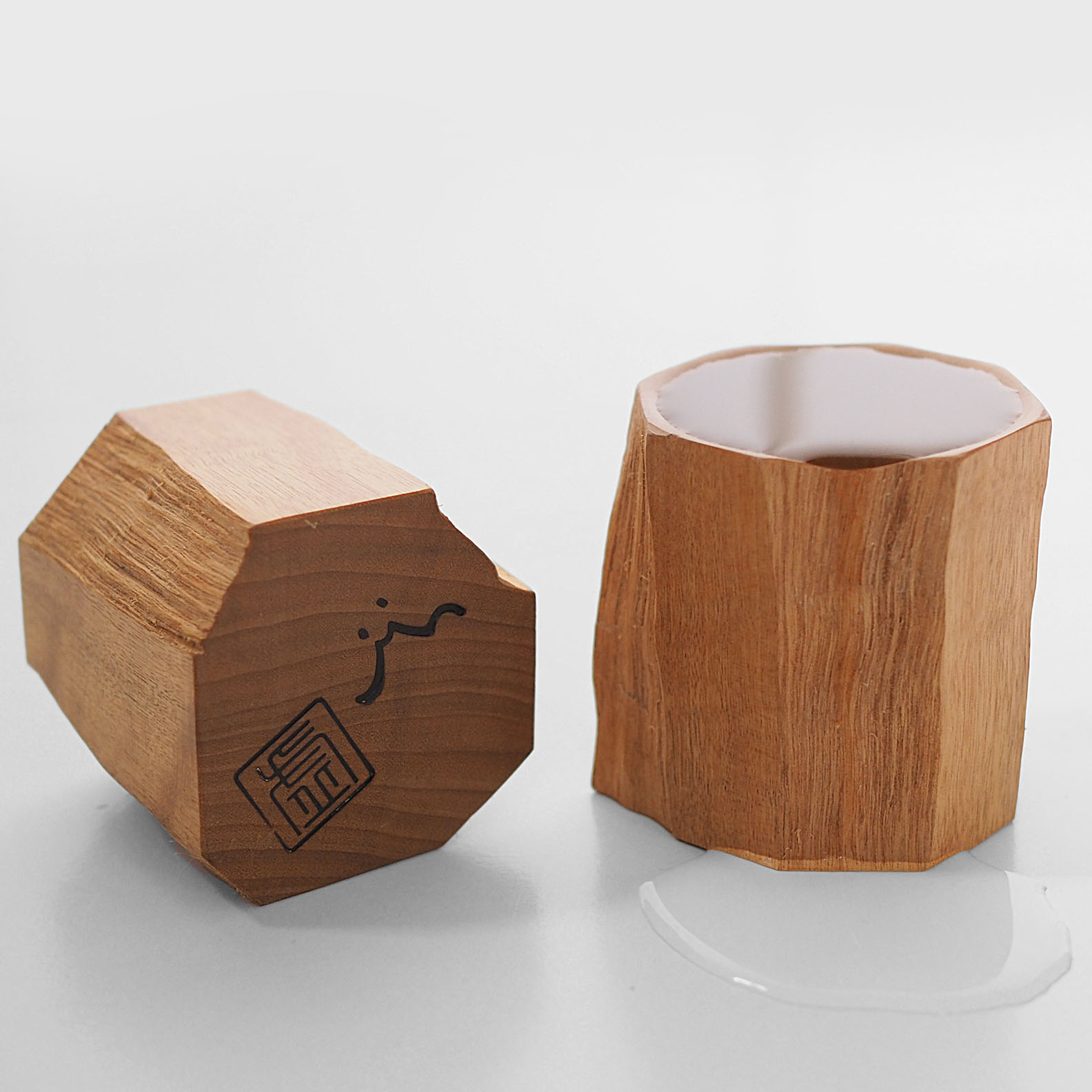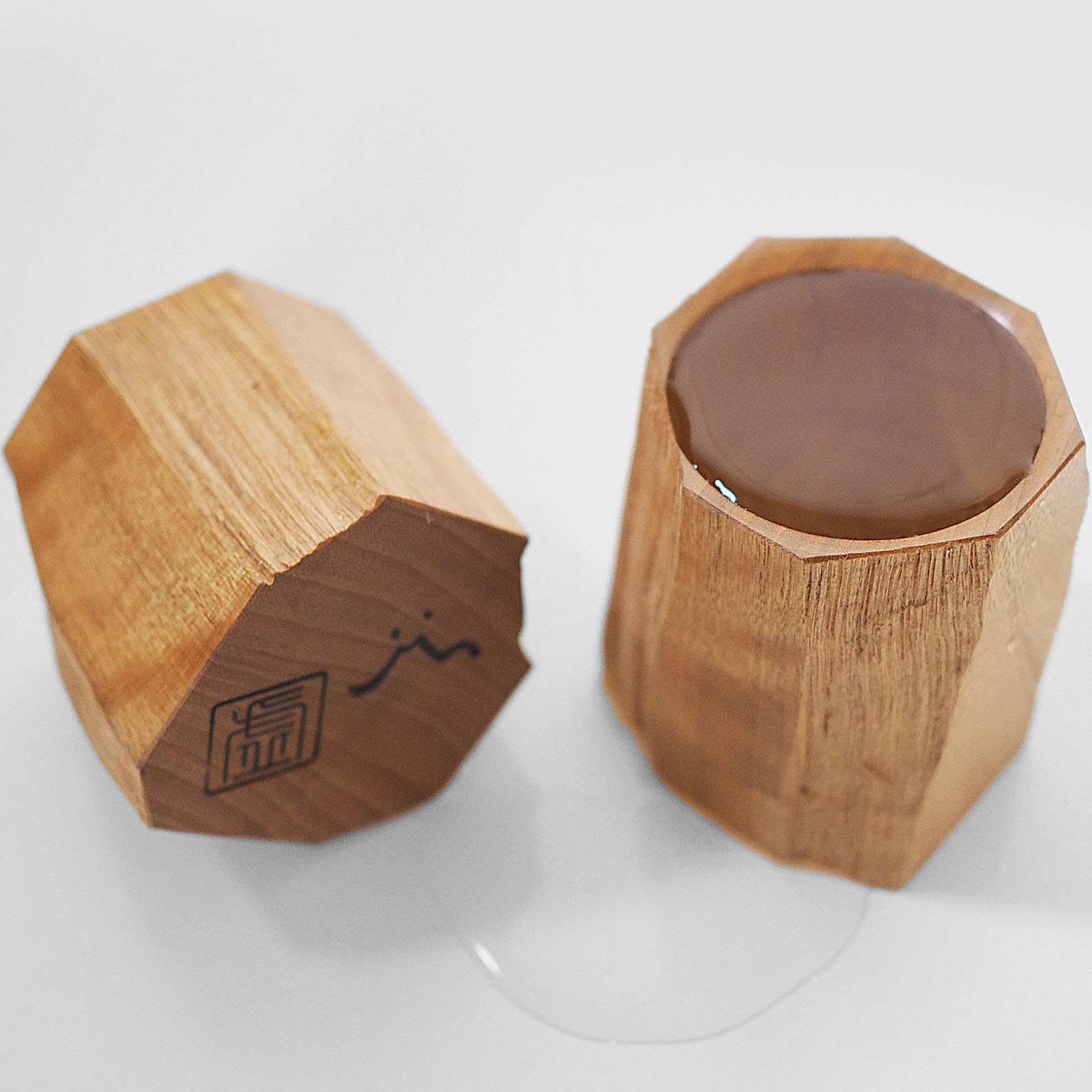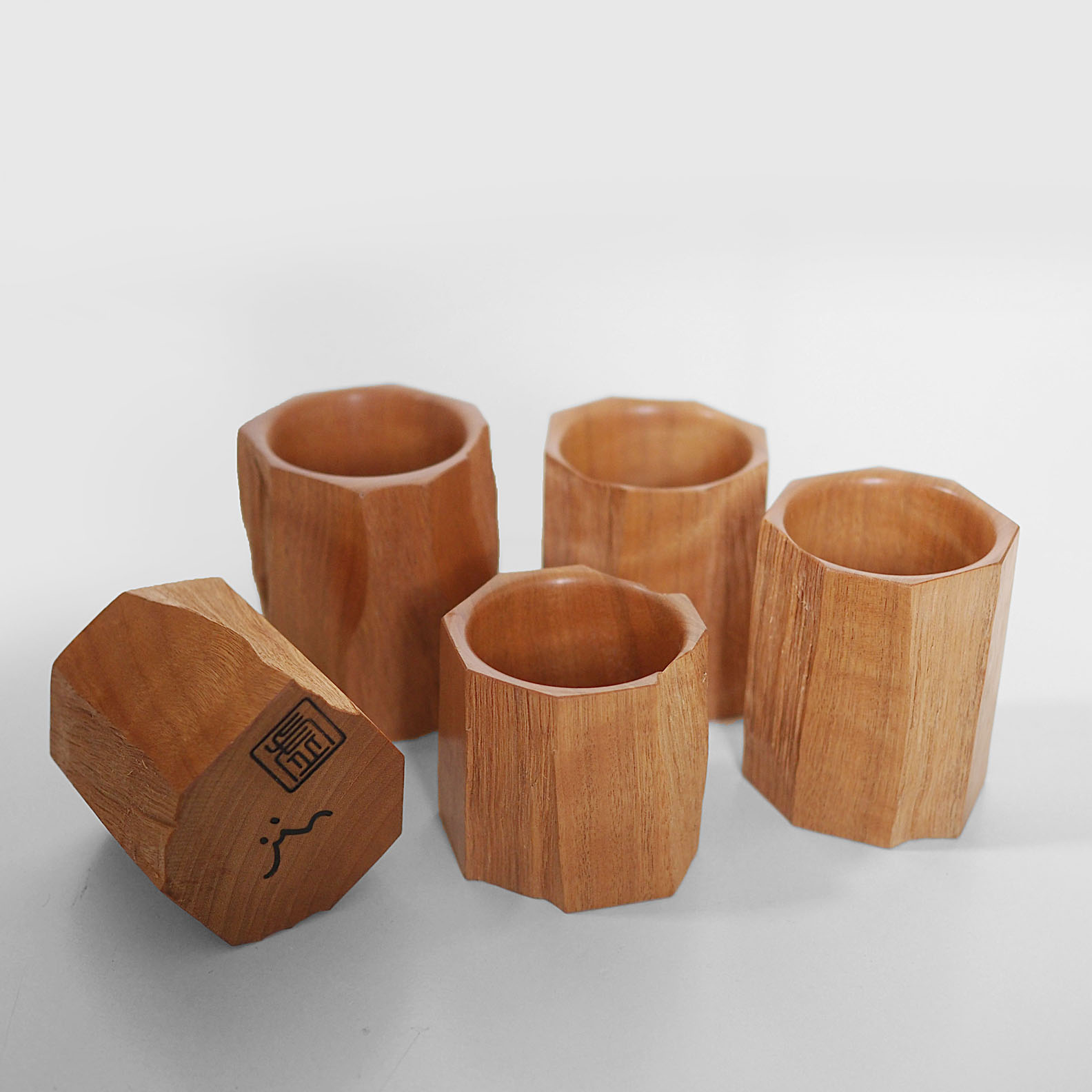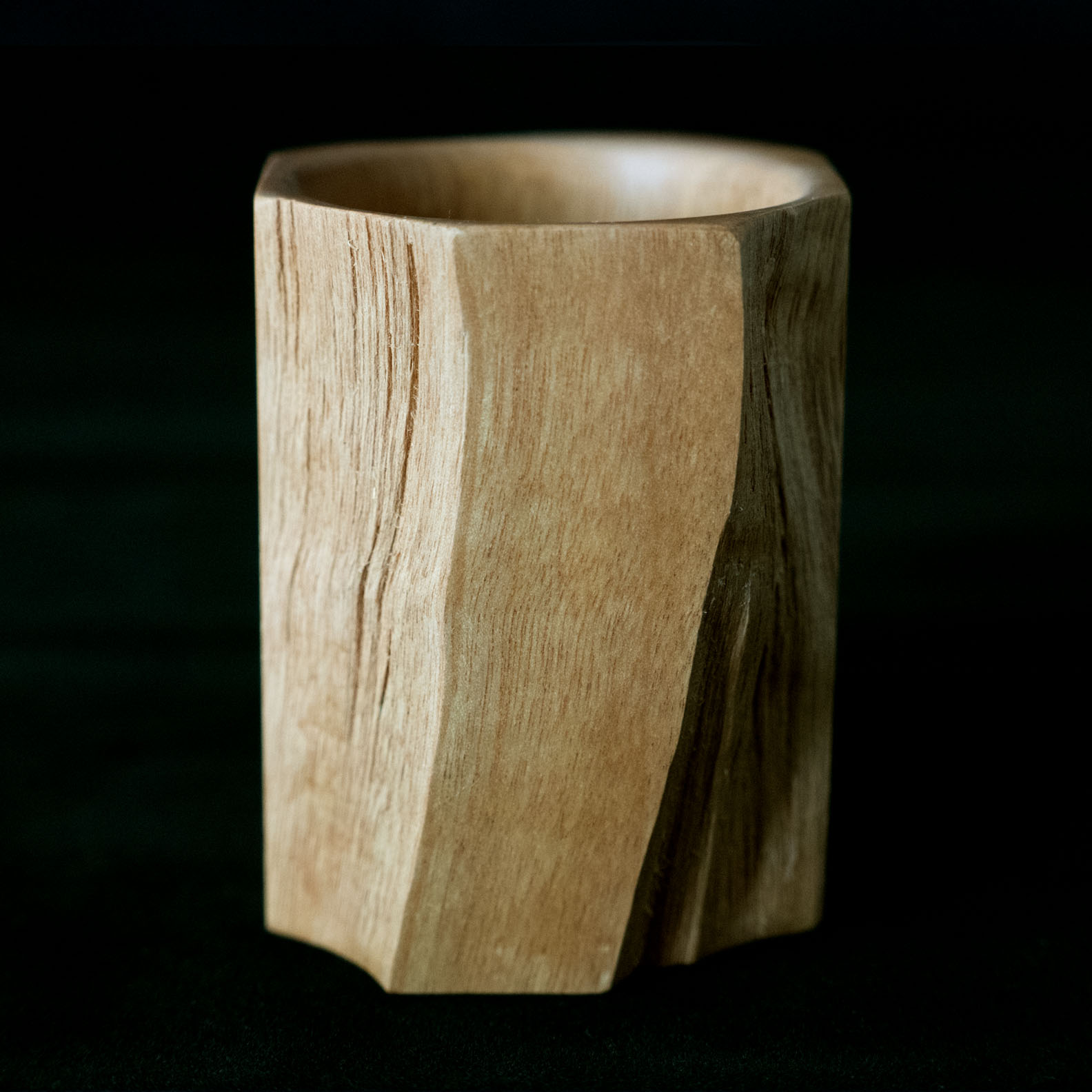Cup "Uro" from Satsuma薩摩
コップ 虚
アキヒロジン
アキヒロジン
198×年鹿児島県生まれ
鹿児島で木工作家として活躍する。彼の代表作は美しい鑿痕のついた大人気のJIN CUPシリーズ。
JIN CUPは木を活かした器であり商品として設計されているから、虚(うろ)とは対極のように
見えるかもしれない。しかしJIN CUPという商品の存在が無かったら、虚(うろ)もまた無いし、
石川顕さん×KIKIさんのKiKiSA KiKiLiM、Bonzaipaint®のKiTuNeLimというLiM(Less is More)の
系譜に連なった作でもある。
僕は軽量な山道具を集めて店をやっている。世の中には小さいけどそういう需要があり、作り手
も買い手もちゃんと存在する。僕はその橋渡し役で軽量な山道具たちに囲まれて過ごしている。
けれど結局一番重いのは水だ、とよく思う。山で飲むための水、調理をし、飯を炊くための水。
当たり前だけど1Lで1kg。生きていくための貴重な水。これがズシンと重いのだ。
思ったより手強い山だった。その日の目的地にも着けず、疲労困憊してビバークすることにした。
水は喉を濡らす程度しか残ってないが、尾根近くに水を得られる所はない。困っていると夜半に
雨が降り出した。タープから流れ落ちる雨水を夢中で鍋に集めた。特別な水で作った袋ラーメン
はとても美味しく、心に残る夜となった。
初めてこのコップを見たとき、樹の虚(うろ)のようだよと立沢さんが言ったのがよくわかった。
虚(うろ)に溜まった水。あのありがたい雨のように。
慈悲の水の記憶を僕に思い出させた樹の器。それは樹が宿した軌跡と作家アキヒロジンが対峙し、
その対話を経てから削ってひとつ作られる。ゆえに同じ形は存在しない、しかし不思議にどれも
ほどよく手に馴染むやさしさを持っている。
海千山千會 千代田高史
私たちは器に囲まれて生活している。素材としては木、石、土、金属、紙、ガラス、樹脂などで
それらは出来ていて、用途に合わせて実に様々な形態と意匠を見せている。学生時代に原始的な
器は両手を合わせたものだと教えられた。それから僕はその時々の思いつきで器を買っては捨る
ということを繰り返してきた。数年で飽きたものも、旅先で買って寓居で醒めたこともあった。
その反動で禁欲的になった。些細なことでも気に入らぬ箇所を探しては何ひとつ買わなかった。
その頃から博物館等に収蔵された器を見によく出かけるようになった。こちらは手に入らぬから
気が楽だったが、欲しいとも思わぬものが大多数であることも分かった。そしてそう云う行為が
器自体でなく、器を通して自分自身を見つめていることに気がついた。私や私たちの観念が物を
見ていただけなのだ。そして段々に僕は観念ではなく、別の視点から器を見るようになった。
名あり実あるは是れ物の居(せかい)
名なく実なきは物の虚なるところに在る『荘子』
虚(きょ)なんて言うと小難しくなるが、窪んだところに水は溜まる。へその穴にも溜まるし、
両手に溜めた水で私たちは顔を洗う。樹に出来た樹洞にも水は溜まるが人は器と思っていない。
たしかに道具としての器はそうではないかもしれないが、少しばかり窮屈な器の見方とも思う。
屋久杉の倒木に出来た水溜まりも、西芳寺の黄金池も、様々な生命を育む器ではないだろうか。
虚(きょ)に生命の源である水が湛えられたこの虚(うろ)を目にしたとき僕はそう思った。
海千山千會 立沢木守
物の真に肝要なところはただ虚にのみ存すると彼は主張した。たとえば室の本質は、屋根と壁に
囲まれた空虚なところに見いだすことができるのであって、屋根や壁そのものにはない。水さし
の役に立つところは水を注ぎ込むことのできる空所にあって、その形状や製品のいかんには存し
ない。虚はすべてのものを含有するから万能である。虚においてのみ運動が可能となる。おのれ
を虚にして他を自由に入らすことのできる人は、すべての立場を自由に行動することができるよ
うになるであろう。岡倉覚三『茶の本』
Jin Akihiro
Born in Kagoshima Prefecture in 198x, he is now working as a woodcraft artist in his hometown. His leading work is the popular Jin Cup Series with beautiful wood grain.
Jin Cup is a wooden vessel and designed for commercial use, so it may seem like the complete opposite from Uro, but Uro would not have existed without Jin Cup.
It is part of the LiM (Less is More) line, which includes KiKiSA KiKiLiM by Akira Ishikawa and KIKI, as well as KiTuNeLim by Bonzaipaint®.
I collect lightweight mountain gear to sell in the store. It is a niche market, but there is demand for it with quite a few buyers and sellers. As a go-between, I am constantly surrounded by lightweight mountain gear. However, I realized that the heaviest item to carry is actually water—water for drinking in the mountains, for cooking and for making rice. Water is important for our survival, but each liter we take means carrying an extra kilogram.
One day, I was on a mountain that was more challenging than expected. I was not able to reach my target destination for the day, and feeling utterly exhausted, I decided to set up a bivouac.
I only had enough water left to wet my lips, and I could not find any near the ridge where I was.
Just as I was getting worried, it began to rain at night. I hurriedly collected the rainwater that rolled off my tarp into a pot. The bowl of ramen I cooked with that special water tasted heavenly and it became a memorable night.
The first time I saw this cup, I understood immediately what Kimamori meant when he said that the cup looks like a hollow (uro) tree. It reminded me of the time when the sky opened up and blessed me with water. I can imagine water filling up the cup, just like I did with my pot that night.
The artist, Jin Akihiro, inspects the pattern of wood fibers carefully before carving a cup. As a result, all the cups are unique and have different shapes, but remarkably, they have the same smoothness to the touch.
By Takashi Chiyoda
We are surrounded by tools in our daily life. Depending on the purpose, different shapes and designs are adopted to build tools using a range of materials such as wood, stone, metal, paper, glass and resin.
When I was a university student, I was taught that the first primitive tool was created when humans put their two palms together. After graduation, I would constantly buy things on a whim and throw them out. Some I grew sick of in a few years, and some I bought while traveling and found temporary homes for. Gradually, I stopped wanting to buy things. As soon as I found something I do not like about an object, no matter how small, I would put it back down.
At the same time, I began to visit museums to look at the objects on display. It was liberating because I could not purchase any of it, and I also discovered that, in fact, there were many things that I did not want. I realized that I was not looking at the object itself, but at myself through those objects. We look at objects based on our ideals. Eventually, I stopped doing that and began to look at objects from a different perspective.
Any place with a hollow space, even our navel, will collect water. We cup our hands to collect water when we wash our face. Similarly, tree holes collect water, but nobody considers it to be a vessel. Understandably so, but I think it can be regarded as a container. Both the Golden Pond in Saihoji, Kyoto, and the pool of water in a fallen Yakusugi tree in Yakushima island are containers where many living things grow.
That was what came to mind when I saw this empty vessel filled to the brim with water—the source of life.
By Kimamori Tachizawa
He claimed that only in vacuum lay the truly essential. The reality of a room, for instance,
was to be found in the vacant space enclosed by the roof and walls, not in the roof and
walls themselves. The usefulness of a water pitcher dwelt in the emptiness where water
might be put, not in the form of the pitcher or the material of which it was made.
Vacuum is all potent because all containing. In vacuum alone motion becomes possible.
One who could make of himself a vacuum into which others might freely enter would
become master of all situations. THE BOOK OF TEA by OKAKURA-KAKUZO 1906










